warning MAZDA MODEL RX 8 2010 (in English) Owner's Manual
[x] Cancel search | Manufacturer: MAZDA, Model Year: 2010, Model line: MODEL RX 8, Model: MAZDA MODEL RX 8 2010Pages: 438, PDF Size: 7.02 MB
Page 41 of 438
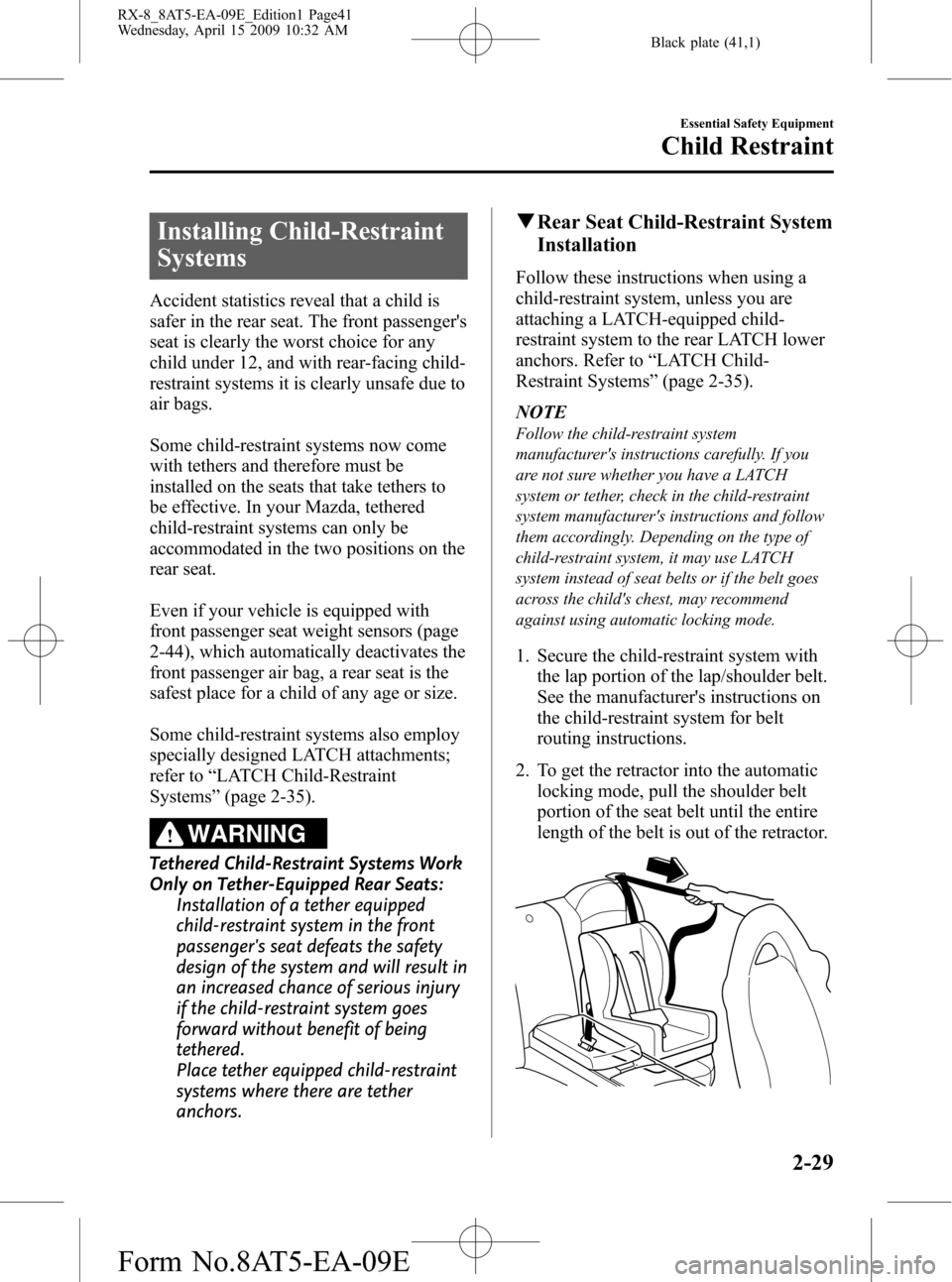
Black plate (41,1)
Installing Child-Restraint
Systems
Accident statistics reveal that a child is
safer in the rear seat. The front passenger's
seat is clearly the worst choice for any
child under 12, and with rear-facing child-
restraint systems it is clearly unsafe due to
air bags.
Some child-restraint systems now come
with tethers and therefore must be
installed on the seats that take tethers to
be effective. In your Mazda, tethered
child-restraint systems can only be
accommodated in the two positions on the
rear seat.
Even if your vehicle is equipped with
front passenger seat weight sensors (page
2-44), which automatically deactivates the
front passenger air bag, a rear seat is the
safest place for a child of any age or size.
Some child-restraint systems also employ
specially designed LATCH attachments;
refer to“LATCH Child-Restraint
Systems”(page 2-35).
WARNING
Tethered Child-Restraint Systems Work
Only on Tether-Equipped Rear Seats:
Installation of a tether equipped
child-restraint system in the front
passenger's seat defeats the safety
design of the system and will result in
an increased chance of serious injury
if the child-restraint system goes
forward without benefit of being
tethered.
Place tether equipped child-restraint
systems where there are tether
anchors.
qRear Seat Child-Restraint System
Installation
Follow these instructions when using a
child-restraint system, unless you are
attaching a LATCH-equipped child-
restraint system to the rear LATCH lower
anchors. Refer to“LATCH Child-
Restraint Systems”(page 2-35).
NOTE
Follow the child-restraint system
manufacturer's instructions carefully. If you
are not sure whether you have a LATCH
system or tether, check in the child-restraint
system manufacturer's instructions and follow
them accordingly. Depending on the type of
child-restraint system, it may use LATCH
system instead of seat belts or if the belt goes
across the child's chest, may recommend
against using automatic locking mode.
1. Secure the child-restraint system with
the lap portion of the lap/shoulder belt.
See the manufacturer's instructions on
the child-restraint system for belt
routing instructions.
2. To get the retractor into the automatic
locking mode, pull the shoulder belt
portion of the seat belt until the entire
length of the belt is out of the retractor.
Essential Safety Equipment
Child Restraint
2-29
RX-8_8AT5-EA-09E_Edition1 Page41
Wednesday, April 15 2009 10:32 AM
Form No.8AT5-EA-09E
Page 43 of 438
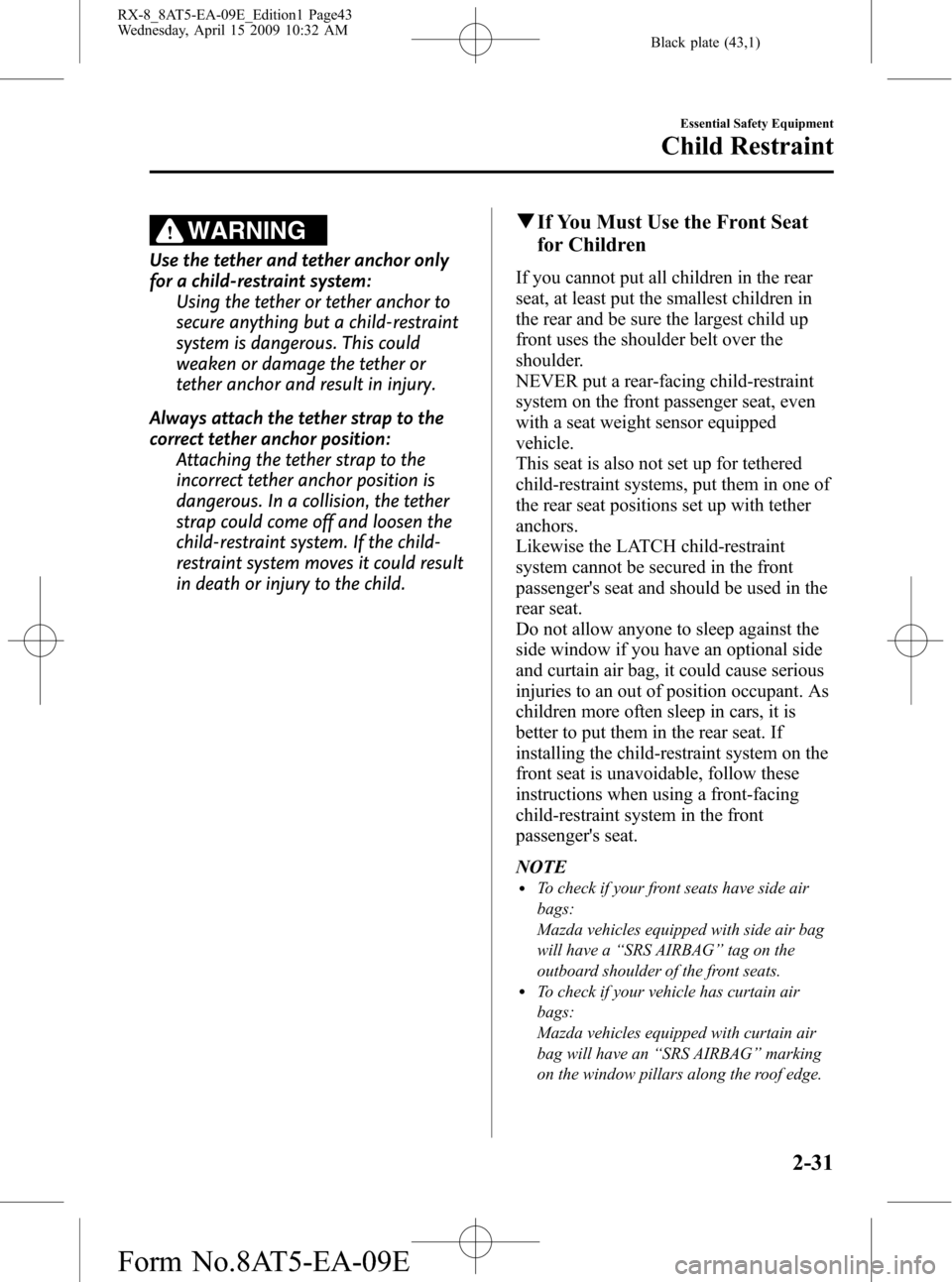
Black plate (43,1)
WARNING
Use the tether and tether anchor only
for a child-restraint system:
Using the tether or tether anchor to
secure anything but a child-restraint
system is dangerous. This could
weaken or damage the tether or
tether anchor and result in injury.
Always attach the tether strap to the
correct tether anchor position:
Attaching the tether strap to the
incorrect tether anchor position is
dangerous. In a collision, the tether
strap could come off and loosen the
child-restraint system. If the child-
restraint system moves it could result
in death or injury to the child.
qIf You Must Use the Front Seat
for Children
If you cannot put all children in the rear
seat, at least put the smallest children in
the rear and be sure the largest child up
front uses the shoulder belt over the
shoulder.
NEVER put a rear-facing child-restraint
system on the front passenger seat, even
with a seat weight sensor equipped
vehicle.
This seat is also not set up for tethered
child-restraint systems, put them in one of
the rear seat positions set up with tether
anchors.
Likewise the LATCH child-restraint
system cannot be secured in the front
passenger's seat and should be used in the
rear seat.
Do not allow anyone to sleep against the
side window if you have an optional side
and curtain air bag, it could cause serious
injuries to an out of position occupant. As
children more often sleep in cars, it is
better to put them in the rear seat. If
installing the child-restraint system on the
front seat is unavoidable, follow these
instructions when using a front-facing
child-restraint system in the front
passenger's seat.
NOTE
lTo check if your front seats have side air
bags:
Mazda vehicles equipped with side air bag
will have a“SRS AIRBAG”tag on the
outboard shoulder of the front seats.
lTo check if your vehicle has curtain air
bags:
Mazda vehicles equipped with curtain air
bag will have an“SRS AIRBAG”marking
on the window pillars along the roof edge.
Essential Safety Equipment
Child Restraint
2-31
RX-8_8AT5-EA-09E_Edition1 Page43
Wednesday, April 15 2009 10:32 AM
Form No.8AT5-EA-09E
Page 44 of 438

Black plate (44,1)
WARNING
Always move the front passenger seat
as far back as possible if installing a
front-facing child-restraint system on it
is unavoidable:
As your vehicle has front air bags
and doubly so because your vehicle
has side air bags, a front-facing
child-restraint system should be put
on the front passenger seat only
when it is unavoidable.
Even if the front passenger air bag
deactivation indicator light
illuminates, always move the seat as
far back as possible, because the
force of a deploying air bag could
cause serious injury or death to the
child.
Never use a rear-facing child-restraint
system in the front seat with an air bag
that could deploy:
Rear-facing child-restraint systems
on the front seat are particularly
dangerous.
Even in a moderate collision, the
child-restraint system can be hit by a
deploying air bag and moved
violently backward resulting in
serious injury or death to the child.
Even though you may feel assured
that the front passenger air bag will
not deploy based on the fact that the
front passenger air bag deactivation
indicator light illuminates.Do not allow a child or anyone to lean
over or against the side window of a
vehicle with side and curtain air bags:
It is dangerous to allow anyone to
lean over or against the side window,
the area of the front passenger seat,
the front and rear window pillars and
the roof edge along both sides from
which the side and curtain air bags
deploy, even if a child-restraint
system is used. The impact of
inflation from a side or curtain air
bag could cause serious injury or
death to an out of position child.
Furthermore, leaning over or against
the front door could block the side
and curtain air bags and eliminate
the advantages of supplemental
protection. With the front air bag and
the additional side air bag that
comes out of the front seat, the rear
seat is always a better location for
children. Take special care not to
allow a child to lean over or against
the side window, even if the child is
seated in a child-restraint system.
qFront Passenger's Seat Child-
Restraint System Installation
1. Slide the seat as far back as possible.
2-32
Essential Safety Equipment
Child Restraint
RX-8_8AT5-EA-09E_Edition1 Page44
Wednesday, April 15 2009 10:32 AM
Form No.8AT5-EA-09E
Page 46 of 438
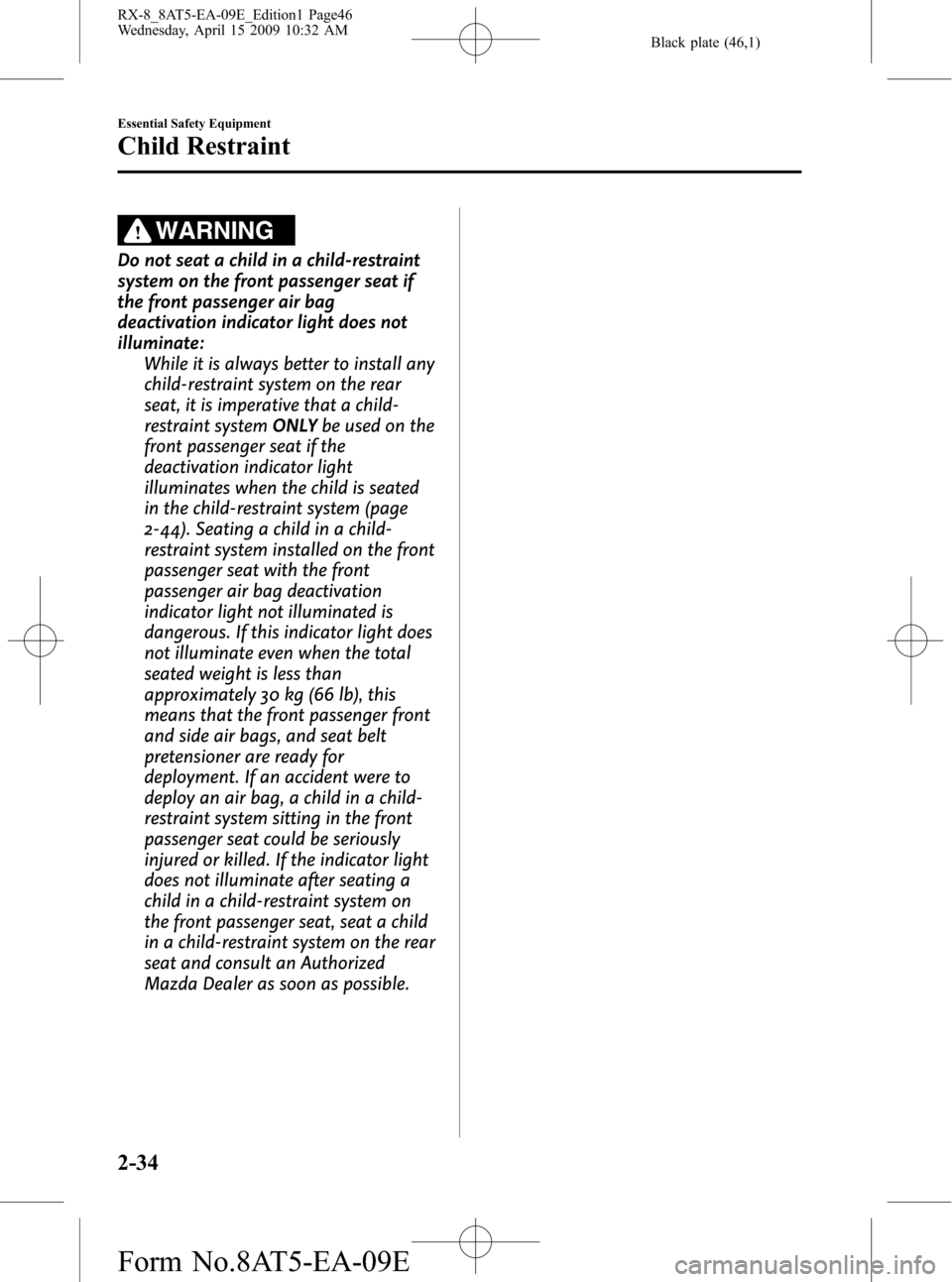
Black plate (46,1)
WARNING
Do not seat a child in a child-restraint
system on the front passenger seat if
the front passenger air bag
deactivation indicator light does not
illuminate:
While it is always better to install any
child-restraint system on the rear
seat, it is imperative that a child-
restraint systemONLYbe used on the
front passenger seat if the
deactivation indicator light
illuminates when the child is seated
in the child-restraint system (page
2-44). Seating a child in a child-
restraint system installed on the front
passenger seat with the front
passenger air bag deactivation
indicator light not illuminated is
dangerous. If this indicator light does
not illuminate even when the total
seated weight is less than
approximately 30 kg (66 lb), this
means that the front passenger front
and side air bags, and seat belt
pretensioner are ready for
deployment. If an accident were to
deploy an air bag, a child in a child-
restraint system sitting in the front
passenger seat could be seriously
injured or killed. If the indicator light
does not illuminate after seating a
child in a child-restraint system on
the front passenger seat, seat a child
in a child-restraint system on the rear
seat and consult an Authorized
Mazda Dealer as soon as possible.
2-34
Essential Safety Equipment
Child Restraint
RX-8_8AT5-EA-09E_Edition1 Page46
Wednesday, April 15 2009 10:32 AM
Form No.8AT5-EA-09E
Page 47 of 438
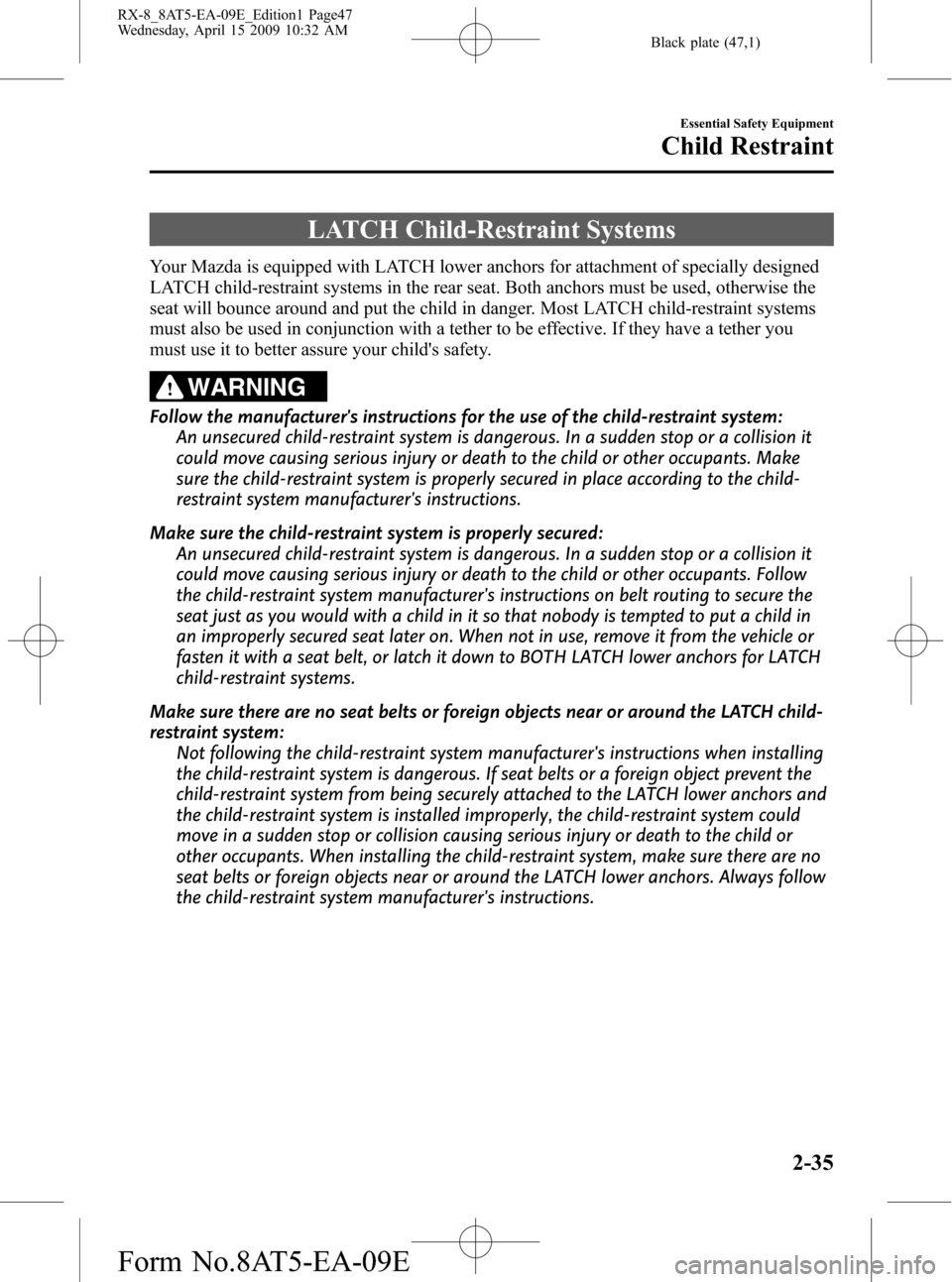
Black plate (47,1)
LATCH Child-Restraint Systems
Your Mazda is equipped with LATCH lower anchors for attachment of specially designed
LATCH child-restraint systems in the rear seat. Both anchors must be used, otherwise the
seat will bounce around and put the child in danger. Most LATCH child-restraint systems
must also be used in conjunction with a tether to be effective. If they have a tether you
must use it to better assure your child's safety.
WARNING
Follow the manufacturer's instructions for the use of the child-restraint system:
An unsecured child-restraint system is dangerous. In a sudden stop or a collision it
could move causing serious injury or death to the child or other occupants. Make
sure the child-restraint system is properly secured in place according to the child-
restraint system manufacturer's instructions.
Make sure the child-restraint system is properly secured:
An unsecured child-restraint system is dangerous. In a sudden stop or a collision it
could move causing serious injury or death to the child or other occupants. Follow
the child-restraint system manufacturer's instructions on belt routing to secure the
seat just as you would with a child in it so that nobody is tempted to put a child in
an improperly secured seat later on. When not in use, remove it from the vehicle or
fasten it with a seat belt, or latch it down to BOTH LATCH lower anchors for LATCH
child-restraint systems.
Make sure there are no seat belts or foreign objects near or around the LATCH child-
restraint system:
Not following the child-restraint system manufacturer's instructions when installing
the child-restraint system is dangerous. If seat belts or a foreign object prevent the
child-restraint system from being securely attached to the LATCH lower anchors and
the child-restraint system is installed improperly, the child-restraint system could
move in a sudden stop or collision causing serious injury or death to the child or
other occupants. When installing the child-restraint system, make sure there are no
seat belts or foreign objects near or around the LATCH lower anchors. Always follow
the child-restraint system manufacturer's instructions.
Essential Safety Equipment
Child Restraint
2-35
RX-8_8AT5-EA-09E_Edition1 Page47
Wednesday, April 15 2009 10:32 AM
Form No.8AT5-EA-09E
Page 49 of 438
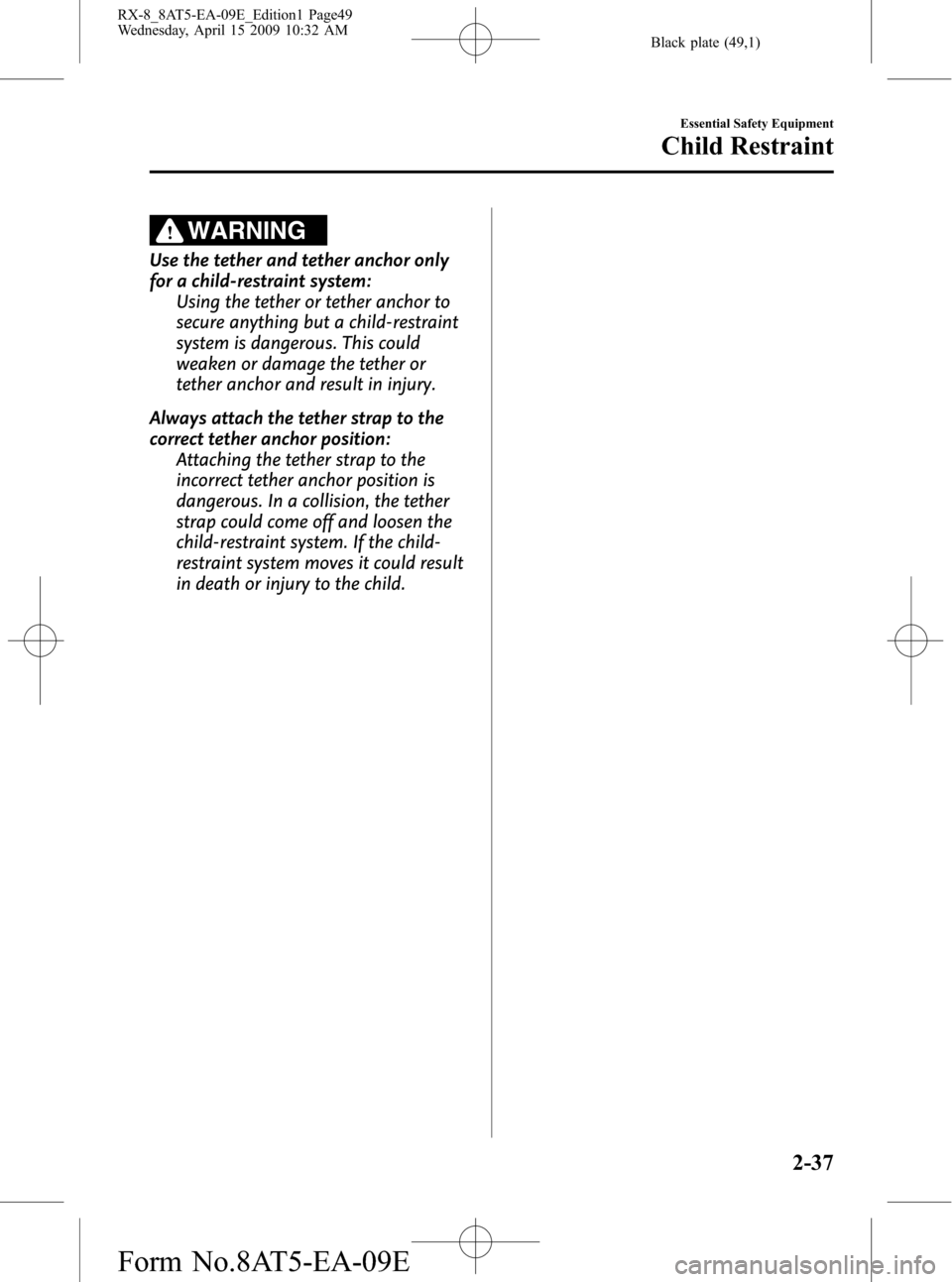
Black plate (49,1)
WARNING
Use the tether and tether anchor only
for a child-restraint system:
Using the tether or tether anchor to
secure anything but a child-restraint
system is dangerous. This could
weaken or damage the tether or
tether anchor and result in injury.
Always attach the tether strap to the
correct tether anchor position:
Attaching the tether strap to the
incorrect tether anchor position is
dangerous. In a collision, the tether
strap could come off and loosen the
child-restraint system. If the child-
restraint system moves it could result
in death or injury to the child.
Essential Safety Equipment
Child Restraint
2-37
RX-8_8AT5-EA-09E_Edition1 Page49
Wednesday, April 15 2009 10:32 AM
Form No.8AT5-EA-09E
Page 51 of 438

Black plate (51,1)
WARNING
Seat belts must be worn in air bag equipped vehicles:
Depending only on the air bags for protection during an accident is dangerous.
Alone, air bags may not prevent serious injuries. The appropriate air bags can be
expected to inflate only in the first collision with frontal, near frontal or side forces
that are at least moderate. Vehicle occupants should always wear seat belts.
Children should not ride in the front passenger seat:
Placing a child, 12 years or under, in the front seat is dangerous. The child could be
hit by a deploying air bag and be seriously injured or even killed. Even if the front
passenger air bag deactivation indicator light illuminates, always move the front
passenger seat as far back as possible. A sleeping child is more likely to lean against
the door and be hit by the side air bag in a moderate, right-side collision. Whenever
possible, always secure a child 12 years and under on the rear seat with an
appropriate child-restraint system for the child's age and size.
Never use a rear-facing child-restraint system in the front seat with an air bag that
could deploy:
Rear-facing child-restraint systems on the front seat are particularly dangerous even
though you may feel assured that a front passenger air bag will not deploy based on
the fact that the front passenger air bag deactivation indicator light illuminates.
The child-restraint system can be hit by a deploying air bag and moved violently
backward resulting in serious injury or death to the child.
Do not sit too close to the driver and front passenger air bags:
Sitting too close to the driver and front passenger air bag modules or placing hands
or feet on them is extremely dangerous. The driver and front passenger air bags
inflate with great force and speed. Serious injuries could occur if someone is too
close. The driver should always hold onto only the rim of the steering wheel. The
front seat passenger should keep both feet on the floor. Front seat occupants should
adjust their seats as far back as possible and always sit upright against the
seatbacks with seat belts worn properly.
Essential Safety Equipment
SRS Air Bags
2-39
RX-8_8AT5-EA-09E_Edition1 Page51
Wednesday, April 15 2009 10:32 AM
Form No.8AT5-EA-09E
Page 54 of 438

Black plate (54,1)
Supplemental Restraint System Components
The supplemental restraint systems (SRS) have two basic subsystems:lThe air bag system with inflators and air bags.lThe electrical system with crash sensors and diagnostic module.
The air bags are mounted in the following locations:
lThe steering wheel hublThe front passenger dashboardlThe outboard sides of the front seatbackslThe front and rear window pillars, and the roof edge along both sides
The air bags are out of sight until activated.
Driver/Front passenger dual stage inflators and air bags
Crash sensors, and diagnostic module (SAS unit)
Front seat belt pretensioners (page 2-19)
Front air bag sensor
Side crash sensors
Air bag/front seat belt pretensioner system warning light (page 2-53)
Side and curtain inflators and air bags
Front passenger air bag deactivation indicator light (page 2-44)
Front passenger seat weight sensors (page 2-44)
Front passenger seat weight sensor control module
2-42
Essential Safety Equipment
SRS Air Bags
RX-8_8AT5-EA-09E_Edition1 Page54
Wednesday, April 15 2009 10:32 AM
Form No.8AT5-EA-09E
Page 56 of 438

Black plate (56,1)
How the Air Bags Work
qHow the Front Air Bags Work
When air bag crash sensors detect a frontal impact of greater than moderate force, an
electrical current is sent to the inflators.
Gases are produced to inflate the front air bags and after the inflation, the front air bags
quickly deflate.
The front air bags will function only once. After that,the front air bags will not work
again and must be replaced.
Only an Authorized Mazda Dealer can replace the system components.
The front, dual stage air bags control air bag inflation in two energy stages. During an
impact of moderate severity the front air bags deploy with lesser energy, whereas during
more severe impacts, they deploy with more energy. Deployment of the front air bags may
differ between the driver and the front passenger depending on the driver seat position,
front passenger weight and front seat belt usage, all of which provide data from each sensor
to the air bag system.
The front air bags will deploy only
in a frontal or frontal offset impact.
Driver seat slide position sensor
Your vehicle is equipped with a driver seat slide position sensor as a part of the
supplemental restraint system. The sensor is located under the driver seat. The sensor
determines whether the driver seat is fore or aft of a reference position and sends the seat
position to the diagnostic module (SAS unit). The SAS unit is also designed to control the
deployment of the driver air bag depending on how close the driver seat is to the steering
wheel.
The air bag/front seat belt pretensioner system warning light flashes if the sensor has a
possible malfunction (page 2-53).
2-44
Essential Safety Equipment
SRS Air Bags
RX-8_8AT5-EA-09E_Edition1 Page56
Wednesday, April 15 2009 10:32 AM
Form No.8AT5-EA-09E
Page 57 of 438

Black plate (57,1)
Front passenger seat weight sensors
Your vehicle is equipped with a front passenger seat weight sensors as a part of the
supplemental restraint system. (page 2-32). These sensors are located under both of the
front passenger seat rails. These sensors determine the total seated weight on the front
passenger seat. The SAS unit is designed to prevent the front passenger front and side air
bags and seat belt pretensioner system from deploying if the total seated weight is less than
approximately 30 kg (66 lbs).
To reduce the chance of injuries caused by deployment of the front passenger air bag, the
system deactivates the front passenger front and side air bags and also the seat belt
pretensioner system when:
lThere is no passenger in the front passenger seat. (The front passenger air bag
deactivation indicator light does not illuminate.)
lThe total seated weight on the front passenger seat is less than approximately 30 kg (66
lbs). (The front passenger air bag deactivation indicator light illuminates.)
This system shuts off the front passenger front and side air bags and seat belt pretensioner
system, so make sure the front passenger air bag deactivation indicator light illuminates
according to the following table.
The air bag/front seat belt pretensioner system warning light flashes and the front
passenger air bag deactivation indicator light illuminates if the sensors have a possible
malfunction. If this happens, the front passenger front and side air bags and seat belt
pretensioner system will not deploy.
Front passenger air bag deactivation indicator light
This indicator light illuminates to remind you that the front passenger front and side air
bags and seat belt pretensioner will not deploy during a collision.
Essential Safety Equipment
SRS Air Bags
2-45
RX-8_8AT5-EA-09E_Edition1 Page57
Wednesday, April 15 2009 10:32 AM
Form No.8AT5-EA-09E